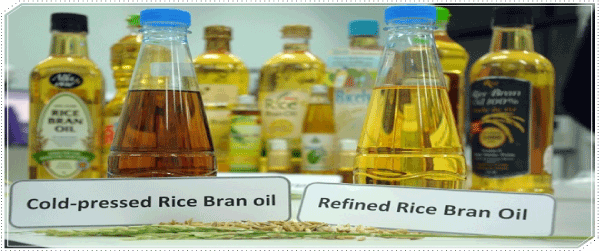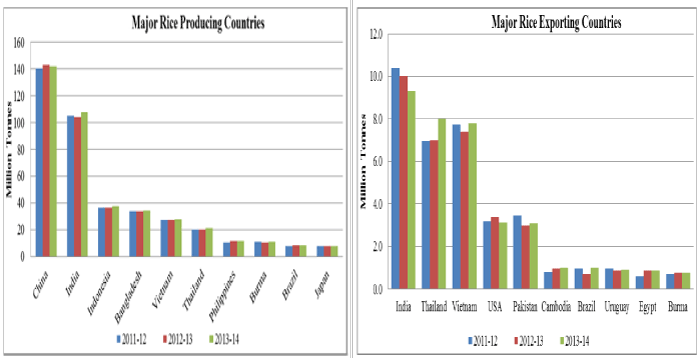Make the best use of Scientific Research and information from our 700+ peer reviewed, Open Access Journals that operates with the help of 50,000+ Editorial Board Members and esteemed reviewers and 1000+ Scientific associations in Medical, Clinical, Pharmaceutical, Engineering, Technology and Management Fields.
Meet Inspiring Speakers and Experts at our 3000+ Global Conferenceseries Events with over 600+ Conferences, 1200+ Symposiums and 1200+ Workshops on Medical, Pharma, Engineering, Science, Technology and Business
Mini Review Open Access
Rice bran oil, the Future Edible Oil of India: A mini Review
| Gulzar Ahmad Nayik*, Ishrat Majid, Amir Gull and Khalid Muzaffar | |
| Department of Food Engineering and Technology, SLIET Longowal (148106) Sangrur, Punjab, India | |
| Corresponding Author : | Gulzar Ahmad Nayik Department of Food Engineering and Technology SLIET Longowal (148106) Sangrur, Punjab, India Tel: 919478153553 E-mail: gulzarnaik@gmail.com |
| Received: August 25, 2015; Accepted: October 01, 2015; Published: October 03, 2015 | |
| Citation: Nayik GA, Majid I, Gull A, Muzaffar K (2015) Rice bran oil, the Future Edible Oil of India: A mini Review. J Rice Res 3:151. doi:10.4172/2375-4338.1000151 | |
| Copyright: © 2015 Nayik GA, et al. This is an open-access article distributed under the terms of the Creative Commons Attribution License, which permits unrestricted use, distribution, and reproduction in any medium, provided the original author and source are credited. | |
| Related article at Pubmed, Scholar Google | |
Visit for more related articles at Rice Research: Open Access
Abstract
Rice bran oil (RBO) also called wonder oil is well known for its numerous health benefits.The presence of a unique antioxidant called oryzanol contributes maximum antioxidant activity to rice bran oil. Rice bran oil has number of advantages over the other edible oil. The present short review will enable the readers and researches about the benefits of RBO.
| Keywords |
| Rice bran oil; antioxidant activity; oryzanol; health benefits |
| Introduction |
| During the polishing process of the rice, a unique vegetable oil rich in antioxidants produced from the outer layer of rice is what we called Rice bran oil (RBO). The studies around the globe have confirmed the cholesterol lowering properties due to presence of unique nutraceutical in this oil known as oryzanol & tocotrienols. The crude rice bran oil is mainly composed of glycerides (80%) while phospholipids, glycolipids, free fatty acids and waxes are also present in less quantity. RBO is extensively used as premium edible oil in most of the Asian countries (Japan, Korea, China, Taiwan and Thailand) [1-5]. It is the conventional & the most favorite cooking medium of the Japanese and is popularly known as “Heart Oil” in Japan. It has acquired the status of a “Functional Food” or a “Health Food” in Western Countries. As per the Cardiologists’ Society of India, 30% of India’s population is prone to cardiac problems. Since every 1% reduction in Cholesterol, reduces the risk of heart attack by 2%, Rice Bran Oil can become a boon for the people. RBO will give better realization of paddy to Indian farmers. The RBO is considered better cooking oil because of its following characteristics: |
| • Most ideal fat composition. |
| • Rice Bran Oil is an excellent alternative for those who have intolerance to other cooking oils because of its hypoallergenic effect. |
| • Rice Bran Oil has a very high smoke (burn) point, making it perfect for deep frying, pan or stirs frying. |
| • Rice Bran Oil creates less polymers (or is less greasy) than other oils meaning better flavor and easier clean-up. |
| • The unique property of the RBO is less oil absorption than other commercial available edible oils which favors the enhanced flavor and palatability. RBO |
| The RBO is rich source of antioxidants especially phytochemical oryzanol, tocopherols and tocotrienols which contribute to higher oxidative stability and longer shelf life than other edible oils. According to the recent studies, the oxidative stability of RBO is 2.5-5 times more than groundnut oil. RBO is good source of mono-unsaturated fats and cholesterol and has been proved to be effective in reducing LDL (bad cholesterol) by 7-10% [6-7]. The high smoking point (213C) prevents fatty acid breakdown at high temperatures which retains its antioxidant activity. |
| • Rice Bran Oil contains a unique phytochemical called oryzanol. |
| The oryzanol is known for its cholesterol reducing property by increasing bile excretion [8]. |
| • It also helps to reduce triglycerides and improves the good cholesterol to bad cholesterol ratio (HDL/LDL) which is very important for heart health [9]. |
| • As discussed earlier Rice Bran Oil has a balanced fatty acid profile as recommended by the World Health Organization (WHO), American heart association’s (AHA), the National Institute of Nutrition (NIN) and the Indian Council of Medical Research (ICMR). |
| Gamma-oryzanol, tocotrienol, tocopherol, squalene and other phtyosterols in rice bran oil possess high antioxidant property against free radicals. Studies have proved that gamma oryzanol is four times effective than tocopherols in inhibiting cellular oxidation [10]. Rice bran oil serves as an important functional food and possesses following health benefits: |
| Better skin |
| The presence of squalene and tocotrienols in rice bran oil helps in skin softening and skin repair. The RBO also protects against harmful UV rays, hence are used in sun screens. |
| Enhances the immune system |
| Being a rich source of gamma oryzanol and other phytosterols, RBO has proved to be effective in improving immune system activity, thereby protecting the body from disease. RBO is used in sport supplements for body builders and athletes for muscle development. |
| Helps prevent cancer |
| The high antioxidant activity of RBO is due to the presence of gamma oryzanol which has ferulic acid like structure [8]. Oryzanol curbs the cancer causing free radicals thereby reducing cancer risk. |
| Nervous system and endocrine health |
| Vitamin E present in RBO helps in improve neurological functioning and balances the endocrine hormones. In hypothyroid patents, gamma oryzanol has been impressive in reducing thyroid stimulating hormone (TSH). Gamma oryzanol has also been fruitful in reducing the menopause problems in women. |
| Processing of Rice Bran Oil |
| RBO in native form when extracted is not readily useable for cooking due to some waxes and free fatty acids that tend to burn and smoke when heated. Thus oil has to be refined to make it acceptable for daily cooking purposes.It needs to be carefully processed without use of chemicals to retain its valuable nutrients – including Oryzanol – even while the unwanted materials are removed from it. |
 |
| Production, Import and Export of RBO |
| During 2012-13 and 2013-14, the world rice production has increased by 1% (from 472 Million Tonnes to 476 Million Tonnes), trade by 8% (from 38 million MT to 41 million MT) and consumption by 3% (from 469 million MT to 481 million MT) (Figure 1 and Table 1). |
| Rice production is estimated to be 88.02 million tons in 2014, four per cent less than last year’s figure; the agriculture ministry’s latest data showed. Production of rice bran oil (RBO) holds immense potential in India considering the surge in paddy production at 150 million tons over the last 10 years. According to The Solvent Extractors Association (SEA) of India, the rice bran oil production in the country is currently at 9 lakh tons (lt) against the potential of 14.6 lakh tons i.e. 75% of total global production of 1.2 million tons. India is leading producer of RBO followed by Japan, Thailand and China. Out of 9 lakh tons of oil produced in India, only 3 lakh tons is consumed as edible while rest is blended with other oils or used by Vanaspati industry. As per SEA data, India RBO production is tremendously increasing 50 thousands annually. If the demand increases there is much more expectation in production increase of RBO. In last five years there has been an increase of 20-30% in RBO consumption. Asian countries like Thailand and Japan have showed much more interest. In 1964 the first Rice bran processing plant was set up Andhra Pradesh followed by in states of Punjab, Haryana and West Bengal. As per CODEX standards the relative density of RBO should be 0.910-0.929, refractive index 1.467-1.470, Saponification value 180-199 and Iodine value should be 136-148 [11-16] (Figure 2). |
| Although RBO is unique edible oil with numerous health benefits but it has a major disadvantage which can outweigh its benefits. The absence of omega-3-fatty acids is the only major problem concerned with RBO. Although RBO reduces cholesterol level but the presence of high excess of omega-6-fatty acids could be detrimental to health. A high consumption of omega-6-fatty acids may increase both breast cancer and prostate cancer. Rice bran itself is potentially high in arsenic so this is another level of concern which requires more research. There are also few side effects of RBO like gas, flatulence, stomach discomfort. RBO has also been reported that it lowers the blood calcium in body which is a health concern for people with hypocalcemia. |
| Future Scenario |
| 1. The state as well as central Government, NGO’s and other private organizations need to identify and explore more utilization of RBO. |
| 2. Awareness among people by doctors, dieticians, cardiologists, nutritionists and health advisors etc. should be done about the health benefits of Rice bran oil. |
| 3. Associations and organizations like Asian Society of Rice Bran Oil, International Solvent Extractors Association of India and International Association of Rice Bran Oil should update frequently the benefits and statistics about RBO. |
References |
|
Tables and Figures at a glance
| Table 1 |
Figures at a glance
 |
 |
| Figure 1 | Figure 2 |
Post your comment
Relevant Topics
- Basmati Rice
- Drought Tolerence
- Golden Rice
- Leaf Diseases
- Long Grain Rice
- Par Boiled Rice
- Raw Rice
- Rice
- Rice and Aquaculture
- Rice and Nutrition
- Rice Blast
- Rice Bran
- Rice Diseases
- Rice Economics
- Rice Genome
- Rice husk
- Rice production
- Rice research
- Rice Yield
- Sticky Rice
- Stress Resistant Rice
- Unpolished Rice
- White Rice
Recommended Journals
Article Tools
Article Usage
- Total views: 24654
- [From(publication date):
November-2015 - Jul 04, 2025] - Breakdown by view type
- HTML page views : 19559
- PDF downloads : 5095
